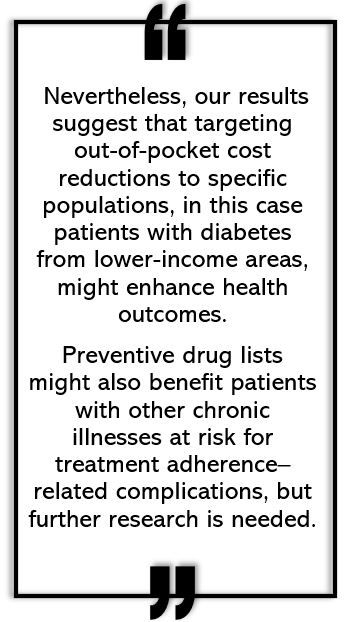Reducing Out-of-Pocket Rx Costs May Help Improve Diabetes Outcomes, Particularly for those with Lower Incomes
Acute, preventable diabetes complications days fell by 8.4% among participants enrolled in a preventive drug list benefit and by even more among low-income subscribers.
Lowering out-of-pocket (OOP) expenses for cardiometabolic medications could potentially improve near-term health results for commercially insured individuals with diabetes, and particularly for those of lower socioeconomic status.
©Natak/stock.adobe.com

The findings, from a large cohort study by researchers at the Harvard Pilgrim Health Care Institute in Boston, were published February 9, 2024, in JAMA Health Forum.
Specifically, among study participants enrolled in an employer’s preventive drug list (PDL) value-based medication benefit, investigators observed an 8.4% reduction in acute, preventable diabetes complication days across the PDL group and a 10.2% decrease among PDL members residing in lower-income areas. These results are in comparison to a group of matched control participants who continued to derive insurance benefits subject to deductibles and/or copayments for their cardiometabolic medications during the study follow-up period.
Some US employers have turned to more generous health insurance programs over the past 10 years to account for the continued rise in OOP costs that often are barriers to obtaining a range of “high-value preventive medications,” including for diabetes, hypertension, hyperlipidemia, and asthma, study authors wrote. The employer’s PDL add-on reduces employee OOP copayments or deductibles and the programs have been shown to increase preventive medication fills among persons with diabetes living in lower-income neighborhoods. What hadn’t been studied, according to first author J Franklin Wharam, MD, MPH, and colleagues, is whether the PDL benefit would yield improved short-term health outcomes in this population.
Wharam and team tapped data from a large national commercial health (and Medicare Advantage) claims database from 2004 to June 2017, for individuals aged 12 to 64 years with diabetes who were enrolled through employers that adopted PDLs, comprising the intervention group. These individuals were matched with members who had diabetes and received insurance coverage through employers that did not use PDLs, comprising the control group, according to the study. The intervention group was granted reduced OOP costs for common cardiometabolic drugs used by persons with diabetes, including noninsulin antidiabetes agents and insulin. For matched controls, medications continued to be subject to copayments and deductibles.
FINDINGS
After completing matching and weighting, the final cohort numbered 10 588 in the intervention group and 690 075 in the control group (mean age 51 years, 55.2% men for both).
Reduced costs. Of note, investigators reported that from baseline to follow-up, OOP costs per 30-day equivalent noninsulin antidiabetic agent and insulin dropped by 30.7% (95% CI −32.6% to −28.8%) and 38.6% (95% CI, −41.1% to −36.2%), respectively, in the PDL group vs controls. Warham et al found similar reductions among PDL participants living in higher- and lower-income areas.
Days covered, use. The team reported that the proportion of days covered by noninsulin antidiabetic agents increased by 4.7% (95% CI, 3.2%-6.2%) in the PDL group and by 7.3% (95% CI, 5.1%-9.5%) among PDL members from lower-income areas compared with controls. Investigators also reported that the proportion of participants whose had higher use of noninsulin antidiabetic agents increased by 11.3% (95% CI, 8.2%-14.5%) in the PDL group and by 15.2% (95% CI, 10.6%-19.8%) among members from lower-income areas compared with controls.
Complications. According to the study, PDL group participants also experienced an 8.4% relative reduction in complication days (95% CI, −13.9% to −2.8%) with an absolute reduction of −20.2 (95% CI, −34.3 to −6.2) per 1000 members per year compared with controls from baseline to follow-up. PDL members residing in lower-income areas had a similar relative reduction of 10.2% (95% CI, −17.4% to −3.0%) with an absolute reduction of −26.1 (95% CI, −45.8 to −6.5) complication days per 1000 members per year.

Considering their findings, the authors suggest that encouraging the use of “targeted cost-sharing reductions” could play an important role in improving health outcomes for commercially insured patients with diabetes, especially those with lower incomes.
“Although we found that residents of lower-income areas with PDLs had a larger magnitude of reduction than counterparts residing in higher-income areas, effect estimates did not differ statistically,” the authors said. “Nevertheless, our results suggest that targeting out-of-pocket cost reductions to specific populations, in this case patients with diabetes from lower-income areas, might enhance health outcomes. Preventive drug lists might also benefit patients with other chronic illnesses at risk for treatment adherence–related complications, but further research is needed.”
Among the study’s limitations the authors caution that findings generalize only to individuals with diabetes enrolled in commercial health plans. Also, assignment to PDL coverage was already determined by employer, clearly a potential source of selection bias. While the analyses suggest that identification of PDL adoption was reliable, the study's reliance on 1-year continuous enrollment could affect generalizability and bias results “toward the null.” Finally, the study’s focus on short-term outcomes opens the door for longer-term studies with larger samples for a better understanding of the impact of PDL enrollment on clinical outcomes.